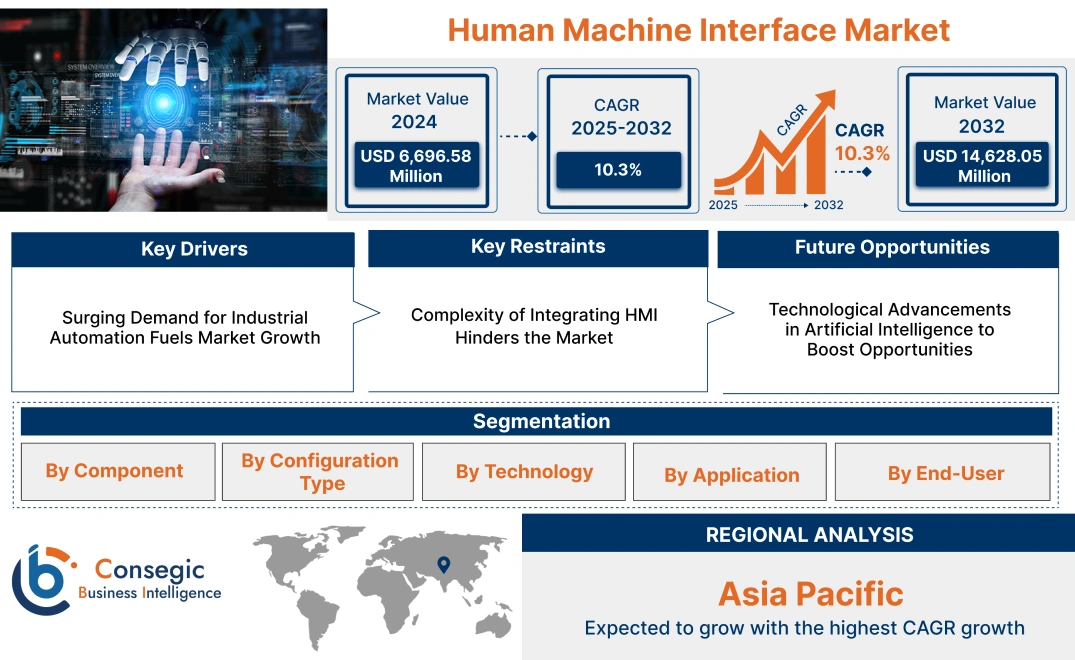Human Machine Interface Market Size:
Human machine interface Market size is estimated to reach over USD 14,628.05 Million by 2032 from a value of USD 6,696.58 Million in 2024 and is projected to grow by USD 7,264.33 Million in 2025, growing at a CAGR of 10.3% from 2025 to 2032.
Human Machine Interface Market Scope & Overview:
A Human Machine Interface (HMI) is a technology that allows humans to interact with machines, facilitating the control and monitoring of systems through various input and output methods. It can connect to physical devices such as touchscreens and control panels as well as software that allows users to communicate with machines and systems in real time. Moreover, these interfaces help to manage production processes, ensure safety during operation, and improve efficiency by providing operators with user-friendly controls and current information. The above-mentioned advantages of human-machine interface play a significant role in the widespread adoption of these technologies in consumer electronics, healthcare, automotive, and various other sectors.
Human Machine Interface Market Insights:
Human Machine Interface Market Dynamics - (DRO) :
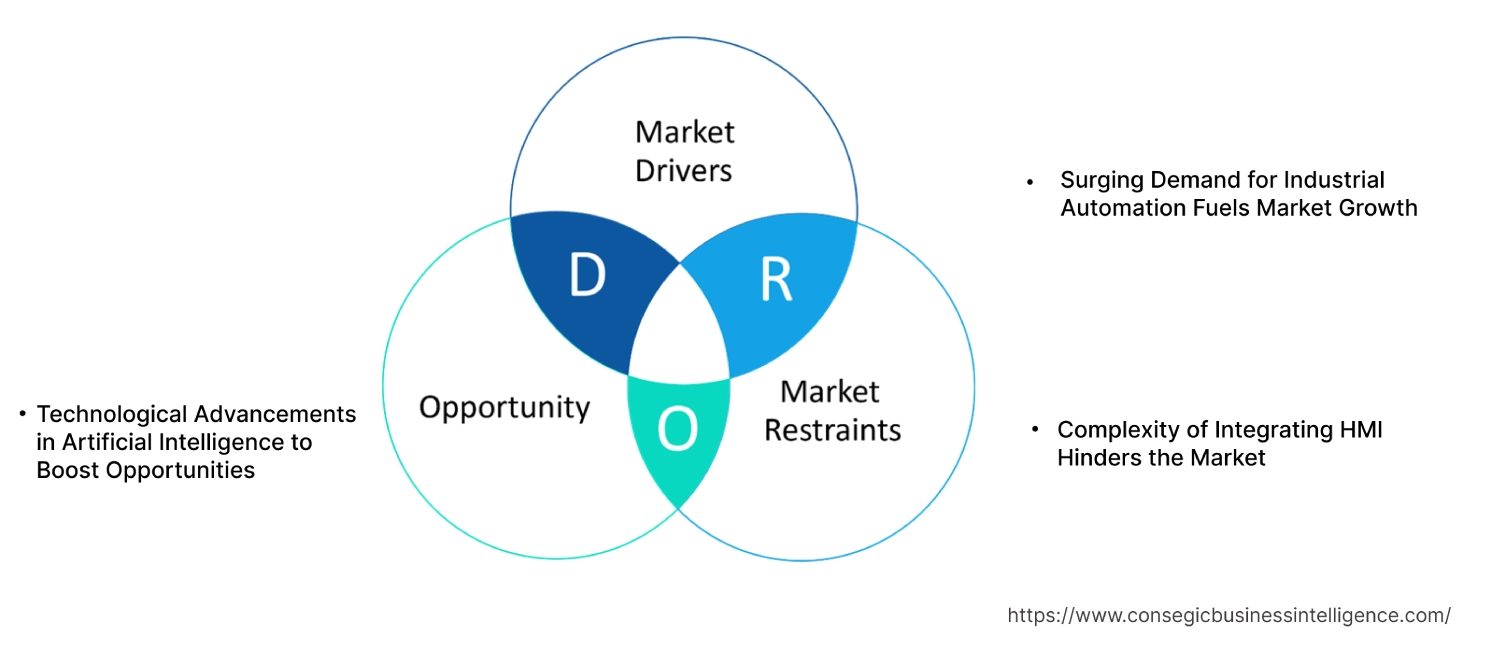
Key Drivers:
Surging Demand for Industrial Automation Fuels Market Growth
Human Machine Interface (HMI) is the collection of devices used by operators to interact with machines in industries where there are automation processes involving robotics, control systems, or computer software. These are required to provide real-time information that is easy to comprehend and allows for the control of operating machines with ease. Furthermore, HMIs also enable monitoring and controlling automated systems thereby improving efficiency, increasing productivity, and reducing downtime.
- In October 2023, software was introduced by Rockwell Automation called FactoryTalk Optix which was designed to enhance human-machine interaction and SCADA functionalities. In addition, this tool changes the way we think about industrial automation design because it enables one to work more easily with its cloud-based model.
Therefore, the increasing need for enhanced efficiency and smoother operations in industrial automation systems is propelling the human machine interface market trend.
Key Restraints :
Complexity of Integrating HMI Hinders the Market
Due to the rise in the need for recent human-machine interface (HMI) solutions to communicate with various legacy systems with unique communication protocols and operational standards, there is a significant challenge that necessitates specialized solutions for compatibility and interoperability. However, modifying these systems not only requires more time but also increases their cost, making it difficult in scenarios with limited resources. Furthermore, organizations must also manage customization requests that meet specific operational requirements, while maintaining flexibility for future applications or technology upgrades serving the same purpose. Hence, the complexity of integrating HMI is restraining the human machine interface market demand.
Future Opportunities :
Technological Advancements in Artificial Intelligence to Boost Opportunities
Analyzing vast operational data, the use of Artificial Intelligence (AI) in HMI greatly strengthens predictive maintenance abilities. AI programs anticipate machine failures in advance enabling swift repair and thus minimizing the chances that a particular machine will go off when needed most. Further, AI-based technology keeps track of equipment vibrations, temperatures, and other important parameters allowing for easier identification of drifts that might suggest potential problems.
- In May 2022, SECO, enlarged its HMI product portfolio. A 21-inch HMI includes a cashless KarL4 payment system and is integrated with SECO's Clea intelligence platform across various devices. This extensive software package for IoT/AI analytics enables customers to quickly collect and display valuable data from their field devices.
Therefore, as per the analysis, AI-based predictive maintenance features in HMI solutions lead to increased efficiency, fueling the human machine interface industry.
Human Machine Interface Market Segmental Analysis :
By Component:
Based on the component, the market is segmented into Hardware, Software, and Service.
Trends in the component:
- The rising popularity of cloud-based HMI software is attributed to its features like real-time data access, remote monitoring, and seamless updates, improving operational efficiency and flexibility.
- The need for managed services in the HMI is on the rise as companies seek to delegate the upkeep, supervision, and enhancement of HMI systems to expert service providers, guaranteeing improved efficiency and minimized downtimes.
The hardware component accounted for the largest revenue share of 57.39% in 2024.
- Soil-based growth of plants is the traditional method of plant production. Soil fosters a complex web of
- Hardware component is the tangible device that the user interfaces with. This might be a monitor, a keypad, a touchpad, or any different type of input tool.
- Touchscreens are commonly utilized in a range of applications, spanning from consumer electronics to industrial control systems. Touchscreens play a major role due to their user-friendly design and intuitive operation.
- Additionally, continuous advancements in display technology including high resolution, better color accuracy, and enhanced durability drive the adoption of advanced HMI hardware.
- In March 2022, Advantech unveiled the first models of its PPC-100 series, PPC-115W and PPC-112W. These RISC-based Android panel PCs offer cost-effective widescreen display computing options suitable for quick deployment and integration with HMI systems. Features include larger displays, multi-touch control, powerful performance, flexibility, and pre-configured solutions.
- Thus, the hardware component segment enables enhanced interactions with machines through physical devices is driving the proliferation of the global human machine interface market share.
The software component segment is anticipated to register the fastest CAGR during the forecast period.
- The HMI's software component is frequently created to be straightforward and user-friendly, allowing operators to easily oversee and manage the system.
- The feature can be personalized to customize the interface according to the specific requirements of the manufacturing process, including graphical displays, alarms, data logging, and analysis.
- Therefore, as per human machine interface market analysis, the features of the software segment collectively drive the global human machine interface market opportunities.
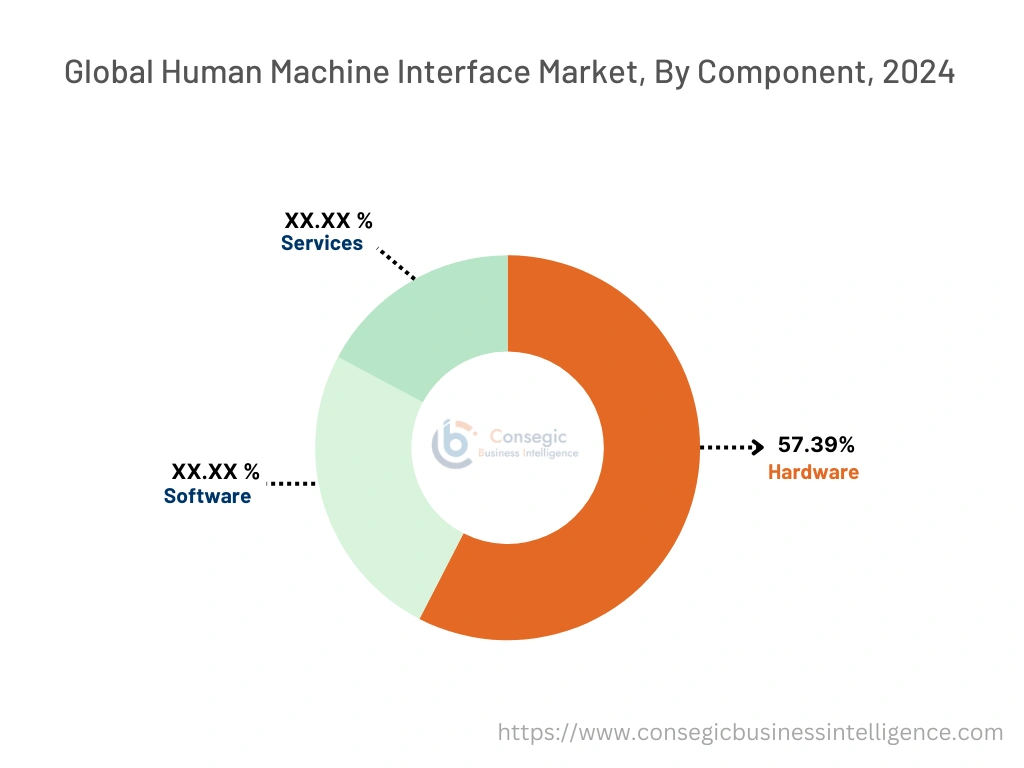
By Configuration Type:
Based on configuration type the market is bifurcated into Embedded HMI and Standalone HMI.
Trends in the configuration type:
- The use of modular design is increasingly important in standalone HMIs, enabling simple upgrades and scalability. This adaptability allows industries to customize their HMI systems based on changing requirements and technological progress.
- Due to the increasing number of connected devices, embedded HMIs are now including strong cybersecurity measures to defend against cyber threats, improving security protocols and encryption to safeguard sensitive industrial data.
The Embedded HMI configuration type accounted for the largest revenue share in the year 2024 and is anticipated to register the fastest CAGR during the forecast period.
- Embedded HMIs essential for machinery, minimizing the requirement for extra parts and streamlining system architecture with decreased installation and maintenance.
- Progress in energy-efficient embedded systems is pushing the increased use of energy-sensitive applications.
- Additionally, features including improved connectivity, customization, flexibility, robust security, and advancements in display enhance the user experience.
- For instance, Honeywell's Advanced Controller HMI is designed to be user-friendly, ergonomic, and robust embedded HMI devices for the Honeywell Advanced plant controllers. The HMI devices feature a capacitive touch-screen display that allows users to view, access, and troubleshoot controller points, IO modules, and other connected equipment at all times.
- Consequently, as per the analysis the aforementioned features of embedded devices are collectively driving and ongoing advancements in embedded devices are anticipated to boost the human machine interface market opportunities.
By Technology:
Based on the distribution channel segment the market is bifurcated into online and offline.
Trends in the Technology:
- Optical HMIs are integrating high-resolution displays and advanced visual interfaces to provide clear and detailed information. Enhanced graphics and augmented reality (AR) overlays improve user interaction and data interpretation
- Increasing integration of bionic HMIs in wearable technology including smart glasses and fitness trackers, enables for seamless and continuous monitoring and control. This tendency supports personalized healthcare and fitness management.
Tactile technology accounted for the largest revenue share in 2024.
- Tactile HMIs provide intuitive and user-friendly interfaces, making them easy to use across various industries.
- Because of constant advancements in touchscreen sensitivity, responsiveness, and durability, tactile HMIs have become even more reliable and globally accepted.
- For instance, Emerson's human-machine product range includes Industrial Monitors and Panel PCs with touchscreen displays for demanding industrial environments.
- Thus, tactile technology due to touchscreen sensitivity is propelling the human machine interface market growth.
The acoustic technology segment is anticipated to register the fastest CAGR during the forecast period.
- Acoustic HMIs are increasingly being adopted for hand-free operation in various applications from smart homes to automated systems.
- These HMIs are incorporating sound-based feedback mechanisms including auditory alerts and confirmations, to enhance operator interaction.
- Additionally, advancements in voice recognition, natural language processing (NLP), multi-modal interaction, and sound-based feedback are the reason for adoption.
- In January 2022, Google launched Nest Hub 2nd Gen, which features a voice-first interface that leverages advanced acoustic HMI technology. With improved voice recognition and NLP capabilities, the device offers seamless voice control for smart home management and other tasks.
- Hence, as per the analysis, voice-recognition and NLP capabilities of acoustic technology are proliferating the human machine interface market growth.
By Application :
Based on application the market is segmented into Automation, Robotics, Digital Signage, Smart Appliances, Remote Control Systems, and Others.
Trends in the Application:
- Digital signage is evolving with the integration of interactive HMIs that enable users to engage with content through touch, gestures, or voice commands. This tendency is followed in retail, advertising, and public information systems.
- The use of human machine interfaces for controlling and programming collaborative robots is growing. These interfaces are created to be easy for users, enabling operators with little technical knowledge to effectively and safely engage with robots.
The automation segment accounted for the largest revenue share in 2024.
- The increasing automation of industry technologies is significantly driving demand for HMIs in industrial automation.
- HMIs are crucial for monitoring and controlling machinery and processes in manufacturing and production environments.
- Additionally, these enhance operational efficiency and productivity in industrial settings by enabling control and feedback to help optimize performance.
- In September 2022, Siemens introduced updates to Desigo CC V6. The system integrates advanced HMI solutions to streamline building automation processes, including energy management, security, and improving operational efficiency and management.
- Therefore, the HMI's ability to monitor and control machinery in automation is fueling the human machine interface market trend.
The smart appliances application Segment is anticipated to register the fastest CAGR during the forecast period.
- The rising need for smart home technology is expanding the trend for smart appliances equipped with advanced HMI interfaces.
- HMIs offer tactile and acoustic technology, remote control, and management in smart appliances causing the widespread.
- In June 2022, Samsung introduced SmartThings Home Life. These appliances include washing machines, ovens, and air conditioners. It features tactile and acoustic HMIs enabling seamless interaction with the broader smart home system.
- Therefore, consumers' preference shifts toward user-friendly interfaces and enhanced controlled smart appliances is expected to grow the human machine interface market.
By End-User:
Based on the end-user the market is segmented into Manufacturing, Packaging, Automotive, Oil & Gas, Energy & Utilities, Food & beverage, Aerospace & Defense, and Others.
Trends in the End-User:
- The advanced Human-Machine Interfaces (HMIs) have been combined into smart packages to enable real-time monitoring and control of automated packaging lines ensuring precision and efficiency.
- HMIs are being designed around the trend towards personalization in vehicles. This has led to manufacturers creating interfaces that allow users to customize settings like climate control, search positions, or even infotainment.
The automotive industry segment accounted for the largest revenue share in 2024.
- With the growing prevalence of Advanced Driver Assistance Systems (ADAS), sophisticated HMIs are needed for driver alerts, navigation, and real-time control.
- Advanced HMIs that combine navigation systems and live traffic updates to enhance route planning and aid drivers.
- In June 2021, BMW iX xDrive50 was launched by BMW. It has the iDrive 8 system with an expansive curved display and voice commands fused with HMI used for navigation, controlling climate, and modifying car settings to improve the driving experience.
- Thus, according to the analysis, interface integration with navigation and management is boosting the human machine interface market demand.
The energy & utilities segment is anticipated to register the fastest CAGR during the forecast period.
- The implementation of smart grids and advanced energy management systems is increasing the demand for HMIs that provide real-time data and control over energy distribution and consumption.
- Additionally, the shift towards renewable energy sources including solar and wind, requires HMIs to manage and optimize the integration of these sources into the existing grid.
- In February 2023, Emerson introduced the Ovation Green portfolio, to assist power generation companies in meeting the requirements of customers transitioning to green energy generation and storage. Showcasing advanced HMI functions for immediate management and surveillance of power generation and utility activities.
- Hence, the need for HMIs for energy management systems is expected to proliferate the human machine interface market.
Regional Analysis:
The regions covered are North America, Europe, Asia Pacific, Middle East and Africa, and Latin America.
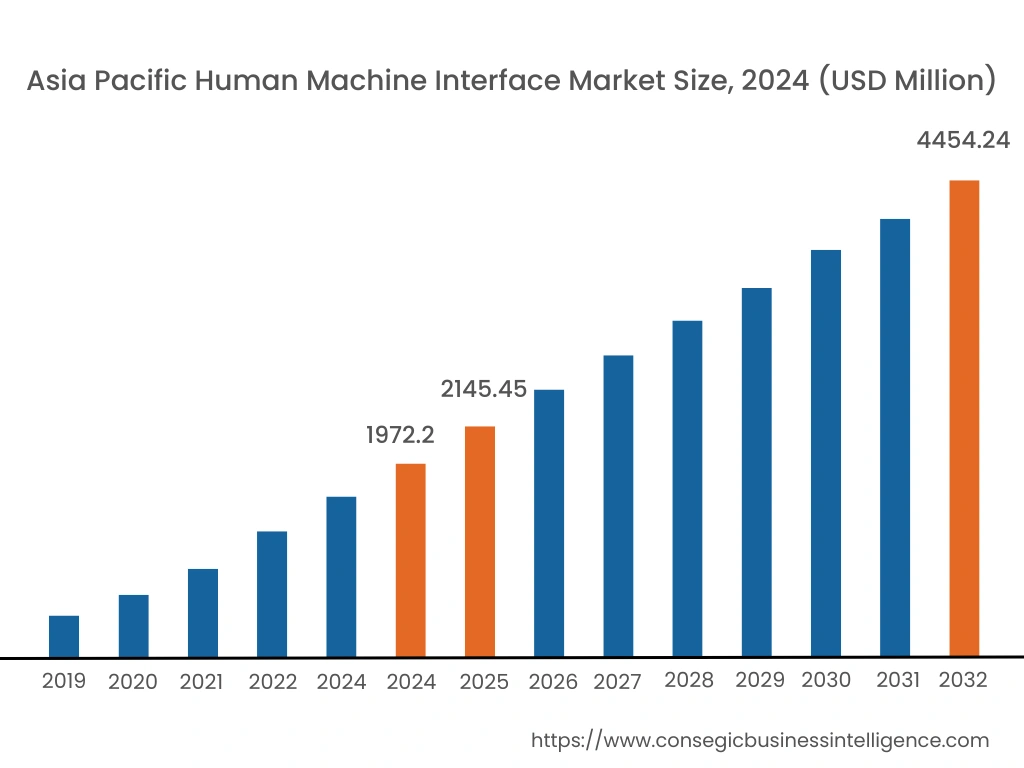
Asia-Pacific region was valued at USD 1,972.20 Million in 2024. Moreover, it is projected to grow by USD 2,145.45 Million in 2025 and reach over USD 4,454.24 Million by 2032. Countries including China, Japan, South Korea, and India are experiencing notable increases in growth. The growth is driven by quick industrialization and the embracing of technology. Furthermore, there is a growing trend towards the expansion of the automotive sector, increased investments in smart-city projects and smart home appliances, higher demand for consumer electronics, and government efforts to promote industrial automation.
- In December 2022, LG Electronics from South Korea introduced ThinQ UP upgradeable household appliances such as refrigerators, washers, dryers, oven ranges, and dishwashers. These intelligent appliances equipped with HMI functions, such as AI, allow users to manage and oversee using touch and sound technology.
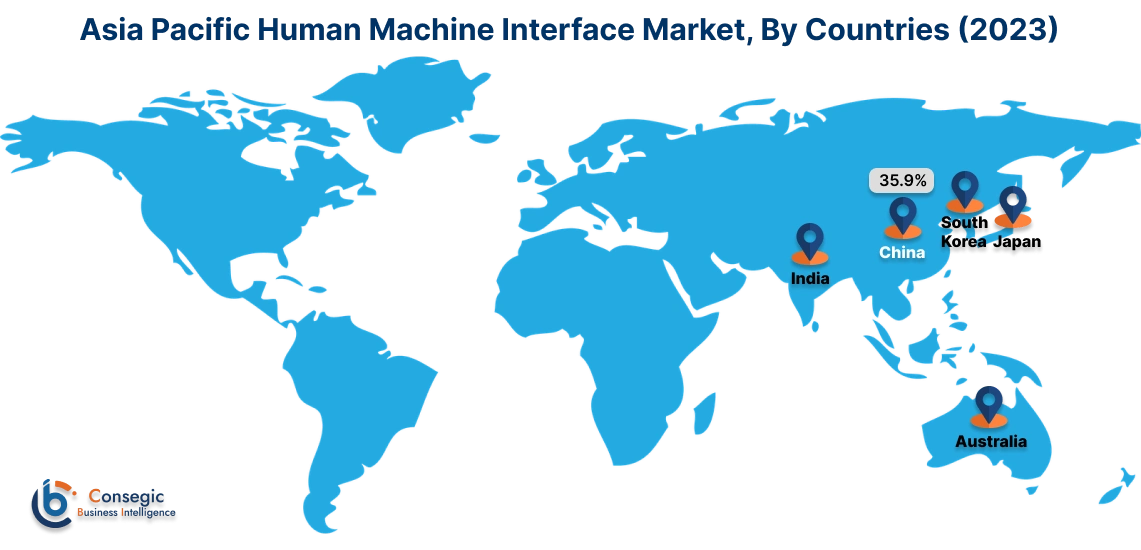
North America is estimated to reach over USD 4,740.95 Million by 2032 from a value of USD 2,221.31 Million in 2024 and is projected to grow by USD 2,405.03 Million in 2025. North America, particularly the United States and Canada, holds a significant portion of the human interface market. The region's expansion is fueled by high adoption rates of advanced technologies in the security, manufacturing, automotive, and energy sectors.
- In September 2023, Johnson Controls (US) launched OpenBlue, which includes HMI functions for overseeing and controlling security devices with added zero-trust cybersecurity measures.
Europe, including Germany, the UK, France, and Italy, plays a significant role in the human-machine interface market. Industrial automation and smart manufacturing are fueling consistent growth in the area.
Latin America is experiencing a growing industrial sector, a rising need for automated solutions, and an increasing focus on enhancing operational efficiency.
The growth of the human machine interface market in the Middle East and Africa is being propelled by a rise in industrialization, investments in city infrastructure projects, and the expansion of the oil and gas sector.
Europe is a prominent market for HMI systems, supported by strong industrial automation, energy efficiency initiatives, and robust automotive and manufacturing industries. Countries like Germany, France, and the UK are key contributors. Germany drives demand through its leadership in Industry 4.0 and smart manufacturing, integrating advanced HMI solutions in production lines. France emphasizes energy-efficient automation systems, while the UK focuses on adopting HMI in process industries and the automotive sector.
The Middle East & Africa region is witnessing steady growth in the HMI market, driven by rising investments in industrial automation, energy infrastructure, and smart city projects. Countries like Saudi Arabia and the UAE are adopting advanced HMI solutions for oil & gas, manufacturing, and infrastructure sectors as part of their economic diversification plans. In Africa, South Africa is emerging as a market with growing industrial automation and energy projects. However, limited access to advanced technologies and high installation costs may restrict broader market development in the region.
Latin America is an emerging market for HMI systems, with Brazil and Mexico leading the region. Brazil's expanding automotive and manufacturing industries drive demand for advanced HMI solutions to improve operational efficiency. Mexico focuses on integrating automation technologies in industrial and energy sectors, supported by growing investments in smart factory initiatives. The region is also witnessing rising demand for HMI in consumer electronics and healthcare industries. However, economic instability and inconsistent technology infrastructure in smaller economies may pose challenges to market growth.
Top Key Players & Market Share Insights:
The human machine interface market is highly competitive with major players providing enhanced interaction and control systems to the national and international markets. Key players are adopting several strategies in research and development (R&D), product innovation, and end-user launches to hold a strong position in the human machine interface market. Key players in the human machine interface industry include-
- Honeywell International, Inc. (US)
- Siemens (Germany)
- Emerson Electric Co (US)
- Rockwell Automation (US)
- Schneider Electric (France)
- Beckhouff Automation (Germany)
- ABB Ltd. (Switzerland)
- Eaton Corporation (Ireland)
- Mitsubishi Electric Corporation (Japan)
- Advantech Co, Ltd (Taiwan)
- Omron Corporation (Japan)
Recent Industry Developments :
Product Launch:
- In February 2024, ABB introduced The ABB Ability Energy Management for Water and Wastewater- OPTIMAX solution, which aids in enhancing efficiency and sustainability in facilities by pinpointing energy wastage. Through the use of HMI technology, overseeing and controlling multiple assets simultaneously can lead to reduced energy consumption and decreased energy costs with the digital optimization tool.
- In February 2024, Siemens launched Gridscale X software HMI, enabling autonomous grid management, accelerating digital transformation for grid operators, improving grid capacity, and increasing visibility of DER for grid decarbonization.
- In June 2023, Apple introduced the Vision Pro headset, which combines eye tracking, hand gestures, and voice commands to improve user engagement with digital content. This device strives to enhance immersion, establishing a fresh benchmark for HMI technologies.
Product Enhancement:
- In May 2023, Microsoft revealed enhancements to its HoloLens technology, with a focus on enhancing teamwork and efficiency in business use. These improvements, such as improved connection with Microsoft Teams, demonstrate a dedication to promoting efficient communication between humans and machines in work environments.
Collaboration:
- In October of 2023, Rockwell Automation and Microsoft joined forces to create cloud-based HMI solutions. The goal of this collaboration is to provide adaptable, safe, and AI-powered HMI platforms for various industrial uses by combining Rockwell's FactoryTalk software with Microsoft Azure, improving remote monitoring and operational effectiveness.
Human Machine Interface Market Report Insights :
| Report Attributes | Report Details |
| Study Timeline | 2019-2032 |
| Market Size in 2032 | USD 14,628.05 Million |
| CAGR (2025-2032) | 10.3% |
| By Component |
|
| By Configuration Type |
|
| By Technology |
|
| By Application |
|
| By End-User |
|
| By Region |
|
| Key Players |
|
| North America | U.S. Canada Mexico |
| Europe | U.K. Germany France Spain Italy Russia Benelux Rest of Europe |
| APAC | China South Korea Japan India Australia ASEAN Rest of Asia-Pacific |
| Middle East and Africa | GCC Turkey South Africa Rest of MEA |
| LATAM | Brazil Argentina Chile Rest of LATAM |
| Report Coverage |
|
Key Questions Answered in the Report
What is human-machine interface? +
A Human-Machine Interface (HMI) refers to the technology that enables interaction between humans and machines, facilitating the control and monitoring of systems through various input and output methods.
What is the key market trend? +
HMIs are increasingly being used to control and program collaborative robots. These interfaces are designed to be user-friendly, allowing operators with minimal technical expertise to interact with robots safely and efficiently.
Who are the major players in the human machine interface market? +
The key players in human-machine interface market are Honeywell International, Inc (US), Siemens (Germany), ABB Ltd (Switzerland), Emerson Electric Co (US), Rockwell Automation (US), Schneider Electric (France), Eaton Corporation (Ireland), Mitsubishi Electric Corporation (Japan), Advantech Co, Ltd (Taiwan), Omron Corporation (Japan), Beckhouff Automation (Germany) and others.
Which is the fastest growing region in the human machine interface market? +
Asia-Pacific is the fastest growing region due to the trend towards expanding the automotive sector, increasing investments in smart-city projects and smart home appliances, raising the demand for consumer electronics, and government initiatives supporting industrial automation.
